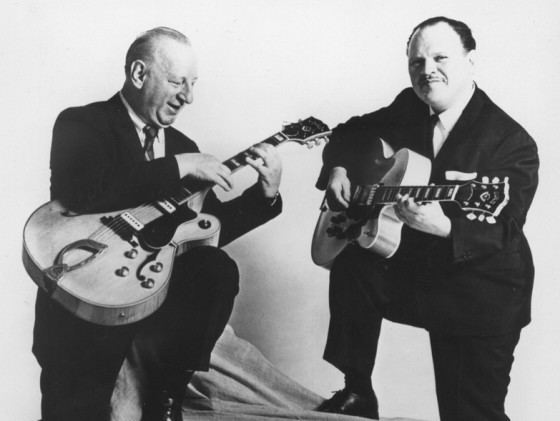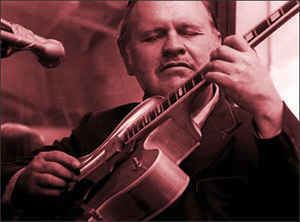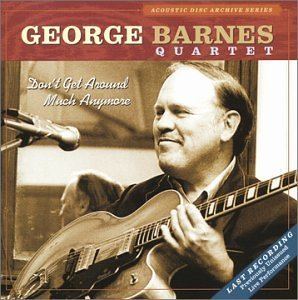Birth name George Warren Barnes Role Guitarist Name George Barnes | Years active 1931–1977 Instruments Guitar | |
 | ||
Genres Jazz, Blues, Swing, Pop, Rock, Country Occupation(s) Guitarist, composer, arranger, conductor, producer, author Labels Okeh, Keynote, Decca, Colortone, Grand Award, Mercury, United Artists, MMO, Carney, Columbia, A&R, Famous Door, Improv, RCA, Chiaroscuro, Concord Jazz Albums Plays So Good, Sounds of Christmas, A Ding Dong Dandy C, Let's Dance with, Guitars Galore | ||
George barnes why was i born 1977
George Warren Barnes (July 17, 1921 – September 5, 1977) was an American swing jazz guitarist who played the first electric guitar in 1931, preceding Charlie Christian by five years. He made the first commercial recording of an electric guitar on March 1, 1938, in sessions with Big Bill Broonzy.
Contents
- George barnes why was i born 1977
- George barnes guitars galore have you met miss jones
- Biography
- First recording with electric guitar
- Style and technique
- Discography
- Singles
- References

George barnes guitars galore have you met miss jones
Biography

Barnes was born in South Chicago Heights, Illinois in 1921. His father was a guitarist and taught Barnes acoustic guitar at the age of nine. A year later, in 1931, Barnes's brother made a pickup and amplifier for him. Barnes said that he was the first person to play electric guitar. From 1935–1937, he had his own band that performed in the Midwest.
On March 1, 1938, he recorded the songs "Sweetheart Land" and "It's a Lowdown Dirty Shame" with blues guitarist Big Bill Broonzy, and in doing so he became the first person to make a record on electric guitar, fifteen days before Eddie Durham recorded on electric guitar with the Kansas City Five. In 1938, when he was seventeen, he was hired as staff guitarist for the NBC Orchestra. He was also staff guitarist and arranger for Decca Records and recorded with Blind John Davis, Jazz Gillum, Merline Johnson, Curtis Jones, and Washboard Sam.

In 1940, Barnes released his first solo recording, "I'm Forever Blowing Bubbles" and "I Can't Believe That You're in Love with Me" on Okeh Records. He was drafted in 1942 and served with the U.S. Army as an intercept operator in the Pentagon. After his discharge in 1946, he formed the George Barnes Octet and was given a fifteen-minute radio program on the ABC network. On January 17, 1947, he married Evelyn Lorraine Triplett in Chicago.

In 1951, he was signed to Decca Records by Milt Gabler and moved from Chicago to New York City. In 1953, he joined the orchestra for the television show Your Hit Parade. The band was conducted by Raymond Scott, and Barnes was a featured soloist. Barnes, Scott, and vocalist Dorothy Collins (Scott's wife) also recorded together.

Barnes worked often as a studio musician in New York City, playing on hundreds of albums and jingles from the early 1950s through the late 1960s. He played guitar on Patsy Cline's New York sessions in April 1957. Although he was primarily a swing jazz guitarist, he participated in hundreds of pop, rock, and R&B recording sessions. He played on many hit songs by the Coasters, on "This Magic Moment" by the Drifters, on "Lonely Teardrops" by Jackie Wilson, and on "Lipstick on Your Collar" by Connie Francis. His electric guitar can be heard in the movie A Face in the Crowd.
He recorded three albums for Mercury Records: Movin' Easy (1960) with his Jazz Renaissance Quintet, Guitar Galaxies (1960), and Guitars Galore (1961). The latter two contained his orchestrations for ten guitars, known as his guitar choir, which used guitars in place of a horn section. The two albums employed a recording technique known as Perfect Presence Sound.
Barnes received the most attention as a jazz guitarist when he recorded as a duo with Carl Kress from 1961–1965. He and Kress were invited to play at the White House Christmas party on December 17, 1964. For the occasion, Barnes wrote "Watusi for Luci" for First Daughter Luci Baines Johnson because she was famous for dancing the Watusi in clubs with Hollywood celebrities. The song was used as the theme for The Clay Cole Show in 1965, when the TV show was renamed Clay Cole's Discotek.
Barnes formed a duo with jazz guitarist Bucky Pizzarelli that lasted from 1969–1972. In 1973, he and cornetist Ruby Braff formed the Ruby Braff–George Barnes Quartet. The quartet recorded several albums, including Live at the New School (Chiaroscuro, 1974), To Fred Astaire with Love (RCA, 1975), and The Rodgers and Hart Songbook (1973) with singer Tony Bennett. From 1973 until 1977, Barnes recorded several well-received solo albums for Concord Jazz and with the quartet he had formed with Braff. He also recorded two albums for jazz violinist Joe Venuti.
Barnes and his wife, Evelyn, left New York City after his last European tour in 1975 to live and work in the San Francisco Bay area. He died of a heart attack in Concord, California in 1977 at the age of 56.
First recording with electric guitar
Barnes played an electric guitar on two songs, "Sweetheart Land" and "It's a Low-Down Dirty Shame", recorded by Big Bill Broonzy and produced by Lester Melrose in Chicago on March 1, 1938. Some historians attribute the first recording with electric guitar to Eddie Durham, Durham's recording in 1935 was the first to record an electrically amplified guitar[1] with Jimmie Lunceford in 'Hittin' The Bottle' that was recorded in New York for the Decca label.[2] Several recordings of an electric lap steel guitar precede both, including recordings by Milton Brown and his Musical Brownies with Bob Dunn on electric lap steel as early as January 1935. But Broonzy's 1938 session with Barnes is the first to feature an electrically amplified (non–lap steel) guitar.
Style and technique
Barnes's style took shape before the development of bebop, and he remained a swing stylist throughout his career. His lines were usually short, melodic, bluesy and "inside" (i.e., diatonic), compared to the chromaticism and long lines of bop-era guitarists. His improvisations often employed call and response phrases, and his tone was clearer, cleaner and brighter than many other jazz guitarists (such as Joe Pass or Jim Hall) and reflected his "happy" approach to music.
Not long before his death, he recorded three live albums—two produced from an April 17, 1977 concert at the San Francisco club Bimbo's 365, the other at the Willows Theatre in Concord, California. The albums are good examples of his swinging, happy and often mischievous style. The albums also include his banter with the audience and his introductions of tunes and his band, giving the listener a glimpse of his sense of humor.
In a review of the album Don't Get Around Much Anymore (material from a 1977 concert in Concord, California, recorded a little more than a month before Barnes's sudden death at the age of 56), Jim Ferguson wrote, "Often overlooked in a sea of more modern-sounding, bebop-oriented guitarists, George Barnes could swing like mad and spin out intricate, frequently bluesy phrases with awesome precision and musicality.... From start to finish, this well-recorded performance demonstrates the qualities that qualify Barnes for a position among the most elite players in the annals of jazz guitar."
In 1942, Barnes wrote the first electric guitar method, The George Barnes Electric Guitar Method, published by Wm. J. Smith. In 1961, he wrote and recorded George Barnes' Living Guitar Method; The Easy Way to Learn All the Chords and Rhythms and Ten Duets for Two Guitars (recorded with his partner Carl Kress) for Music Minus One. In 1965, he wrote How to Arrange for Solo Guitar, published by Peermusic. He also produced the first guitar course offered on cassette tape, The Great George Barnes Guitar Course, published in 1970 by Prentice Hall.
